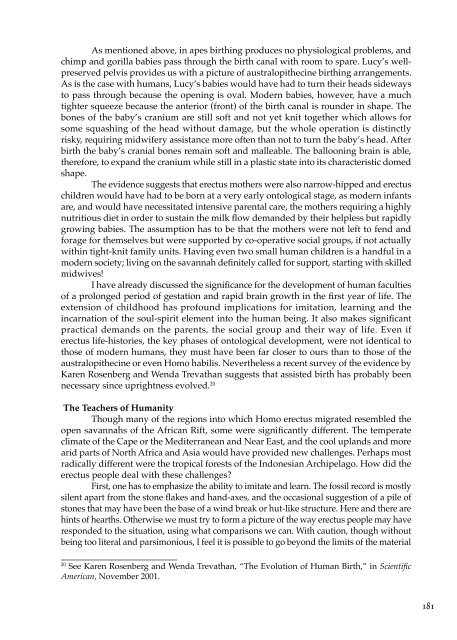The Spirit in Human Evolution - Waldorf Research Institute
The Spirit in Human Evolution - Waldorf Research Institute
The Spirit in Human Evolution - Waldorf Research Institute
Create successful ePaper yourself
Turn your PDF publications into a flip-book with our unique Google optimized e-Paper software.
As mentioned above, <strong>in</strong> apes birth<strong>in</strong>g produces no physiological problems, and<br />
chimp and gorilla babies pass through the birth canal with room to spare. Lucy’s wellpreserved<br />
pelvis provides us with a picture of australopithec<strong>in</strong>e birth<strong>in</strong>g arrangements.<br />
As is the case with humans, Lucy’s babies would have had to turn their heads sideways<br />
to pass through because the open<strong>in</strong>g is oval. Modern babies, however, have a much<br />
tighter squeeze because the anterior (front) of the birth canal is rounder <strong>in</strong> shape. <strong>The</strong><br />
bones of the baby’s cranium are still soft and not yet knit together which allows for<br />
some squash<strong>in</strong>g of the head without damage, but the whole operation is dist<strong>in</strong>ctly<br />
risky, requir<strong>in</strong>g midwifery assistance more often than not to turn the baby’s head. After<br />
birth the baby’s cranial bones rema<strong>in</strong> soft and malleable. <strong>The</strong> balloon<strong>in</strong>g bra<strong>in</strong> is able,<br />
therefore, to expand the cranium while still <strong>in</strong> a plastic state <strong>in</strong>to its characteristic domed<br />
shape.<br />
<strong>The</strong> evidence suggests that erectus mothers were also narrow-hipped and erectus<br />
children would have had to be born at a very early ontological stage, as modern <strong>in</strong>fants<br />
are, and would have necessitated <strong>in</strong>tensive parental care, the mothers requir<strong>in</strong>g a highly<br />
nutritious diet <strong>in</strong> order to susta<strong>in</strong> the milk flow demanded by their helpless but rapidly<br />
grow<strong>in</strong>g babies. <strong>The</strong> assumption has to be that the mothers were not left to fend and<br />
forage for themselves but were supported by co-operative social groups, if not actually<br />
with<strong>in</strong> tight-knit family units. Hav<strong>in</strong>g even two small human children is a handful <strong>in</strong> a<br />
modern society; liv<strong>in</strong>g on the savannah def<strong>in</strong>itely called for support, start<strong>in</strong>g with skilled<br />
midwives!<br />
I have already discussed the significance for the development of human faculties<br />
of a prolonged period of gestation and rapid bra<strong>in</strong> growth <strong>in</strong> the first year of life. <strong>The</strong><br />
extension of childhood has profound implications for imitation, learn<strong>in</strong>g and the<br />
<strong>in</strong>carnation of the soul-spirit element <strong>in</strong>to the human be<strong>in</strong>g. It also makes significant<br />
practical demands on the parents, the social group and their way of life. Even if<br />
erectus life-histories, the key phases of ontological development, were not identical to<br />
those of modern humans, they must have been far closer to ours than to those of the<br />
australopithec<strong>in</strong>e or even Homo habilis. Nevertheless a recent survey of the evidence by<br />
Karen Rosenberg and Wenda Trevathan suggests that assisted birth has probably been<br />
necessary s<strong>in</strong>ce uprightness evolved. 20<br />
<strong>The</strong> Teachers of <strong>Human</strong>ity<br />
Though many of the regions <strong>in</strong>to which Homo erectus migrated resembled the<br />
open savannahs of the African Rift, some were significantly different. <strong>The</strong> temperate<br />
climate of the Cape or the Mediterranean and Near East, and the cool uplands and more<br />
arid parts of North Africa and Asia would have provided new challenges. Perhaps most<br />
radically different were the tropical forests of the Indonesian Archipelago. How did the<br />
erectus people deal with these challenges?<br />
First, one has to emphasize the ability to imitate and learn. <strong>The</strong> fossil record is mostly<br />
silent apart from the stone flakes and hand-axes, and the occasional suggestion of a pile of<br />
stones that may have been the base of a w<strong>in</strong>d break or hut-like structure. Here and there are<br />
h<strong>in</strong>ts of hearths. Otherwise we must try to form a picture of the way erectus people may have<br />
responded to the situation, us<strong>in</strong>g what comparisons we can. With caution, though without<br />
be<strong>in</strong>g too literal and parsimonious, I feel it is possible to go beyond the limits of the material<br />
_________________________<br />
20<br />
See Karen Rosenberg and Wenda Trevathan, “<strong>The</strong> <strong>Evolution</strong> of <strong>Human</strong> Birth,” <strong>in</strong> Scientific<br />
American, November 2001.<br />
181
















